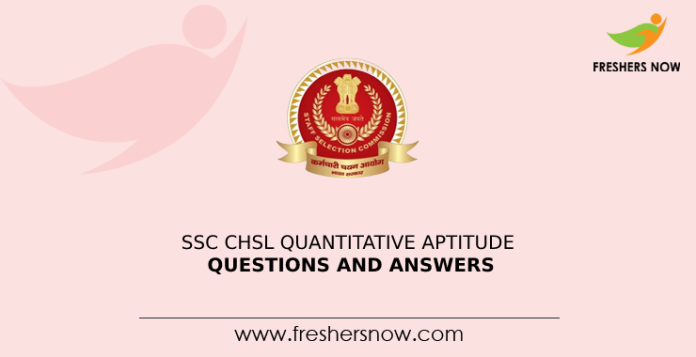
SSC CHSL Quantitative Aptitude Questions and Answers: Worried about how to prepare for the SSC CHSL Quantitative Aptitude section? Then, here is an article that can help you learn the Quantitative Aptitude Questions for the SSC CHSL Exam and practice them with ease. We have provided SSC CHSL Quantitative Aptitude Practice Questions based on the syllabus provided by the officials. If you have checked the syllabus, you might be aware that the SSC CHSL Quantitative Aptitude section carries a weightage of 25 questions for 50 marks, and in order to score full marks, you must be thoroughly prepared.
SSC CHSL Quantitative Aptitude Practice Questions
Now practice the Quantitative Aptitude Questions For SSC CHSL Exam that we have given below daily, so that you can ensure to ace the exam easily.
1. An alloy has Gold and Copper in ratio 3:4. Another alloy has Gold and Copper in ratio 5:3. In what ratio they should be mixed so that the final mixture has Gold and Copper in ratio 5:4?
(A)17:32
(B) 9:16
(C) 71:128
(D) 35:64
Answer: D
Explanation:
Let M kg of the first alloy and N kg of the second alloy be mixed.
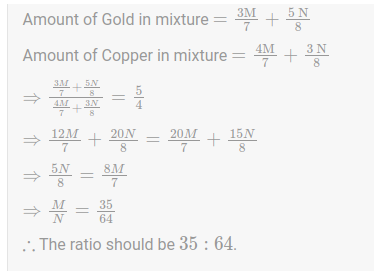
2. If a metallic cone of radius 24 cm and height 48 cm is melted and recast into metallic spheres of radius 6 cm, find the number of spheres.
(A) 32
(B)42
(C) 48
(D)24
Answer: A
Explanation:
Given: A metallic cone of radius 24 cm and height 48 cm recast into metallic spheres of radius 6 cm. The volume of sphere = (4/3)πr³ The volume of a cone = (1/3)πr²h Let the number of spheres required of radius 6 cm be ‘n’. So the total volume of the spheres = n x(4/3)π × 63 Volume of the metallic cone = (3)πr²h Now, Volume of metallic cone = Volume of n spheres ⇒(1/3) (24)² × 48 = n(4/3)π(6)³ 128=4n ⇒n=32 .. Total number of spheres formed are 32.
3. ![]()
(A)15
(B)25
(C) 10
(D) 20
Answer: A
Explanation:
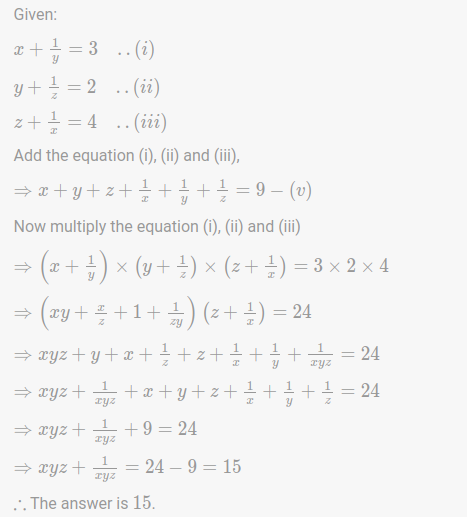
4. The curved surface area of cylinder is 88 sq.cm. The radius of cylinder is 8.6 less than the height of cylinder. The ratio between the radius of cylinder and radius of sphere is 2 : 3. Find the volume of sphere.
(A)32 cubic.cm
(B) 39 cubic.cm
(C) 41 cubic.cm
(D)46 cubic.cm
Answer: B
Explanation:
Given:
Curved surface area of cylinder = 2πrh = 88
⇒ rh = 14
⇒ r = h – 8.6
Solving,
⇒ r = 1.4 cm and h = 10 cm
Radius of sphere = 1.4×3/2=2.1 cm, because radius of cylinder and radius of sphere is 2:3. ⇒ Volume of sphere = 4/3πr³ = 4/3× 22/7 × (2.1)³
= 38.808 ≈ 39 cubic.cm
∴ Volume of sphere = 39 cubic.cm
5. Direction: Study the following data and answer the following question.
The following line graph shows the literate and illiterate population of five villages.
Total population = literate population + illiterate population
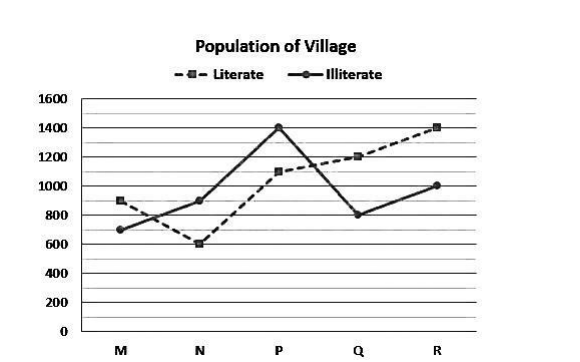
Find the difference between the literate and illiterate populations of five villages.
(A) 300
(B) 550
(C) 750
(D) 400
Answer: D
Explanation:
Given:
Total literate population of five villages =900+600+1100+1200+1400=5200
Total illiterate population of five villages =700+900+1400+800+1000=4800
Required difference,=5200−4800
=400
6. If a-b = 3 and a³ – 6³ = 279, then what is the value of a³ + b³?
(A) 317
(B) 407
(C) 297
(D) 502
Answer: B
Explanation:
From the identity: (a – b)³ = a³ – b³ — 3ab(a – b) 3³=279-3ab x 3 9ab=279-27 = 252 ⇒ ab = 28 Now, (a+b)² = (a – b)² + 4ab = (a+b)² = 3²+ 4 × 28 = 121 = (a + b) = 11 Now, (a+b)³ = a³ + b³+3ab(a+b) ⇒ 11³= a³+b³ + 3 x 28 x 11 ⇒ 1331=a³+b³+924 ⇒a³+b³ = 407
7. PT is a tangent drawn from P, given outside the circle, with center O touching the circle at Q. If PQ = 30 cm and the diameter of the circle is 32 cm, then what is the length of OP?
(A) 32
(B) 38
(C) 34
(D) 36
Answer: C
Explanation:
Given:
PQ = 30 cm
Diameter = 32 cm
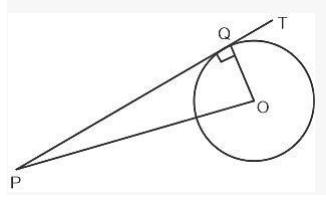
OQ is the radius of a circle OQ = 16 cm Angle OQP = 90° Now apply Pythagoras theorem to: OP² = PQ² + 0Q2 ⇒ OP² = 16² +30² ⇒ OP = 1156 ⇒ OP = 34 cm .. The length of OP is 34 cm.
8. Which of the following is not a perfect square?
(A) 1250
(B) 16641
(C) 2025
(D) 9801
Answer: A
Explanation:
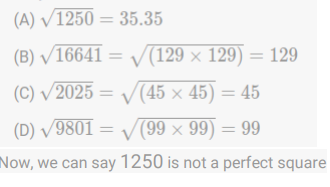
9. Eight members of a club donate Rs. 1000 each towards a Relief Fund and the President of the club donates Rs. 500 more than the average donation of all (including President) of them. Then the contribution of the president is:
(A)Rs. 1062.5
(B) Rs. 1562.5Correct Answer
(C) Rs. 562.5
(D)Rs. 2062.5
Answer: B
Explanation:
Eight members of a club donate Rs. 1000 each
Total amount given by 8 members = Rs. 8000
Let the average donation of all = Rs. x
Contribution of the President = Rs. x+500
We know that,
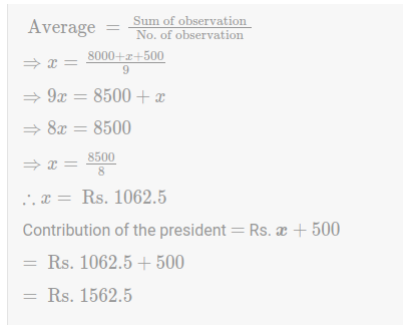
10. If the seven-digit number 16×208 is divisible by 11 and the four-digit number 953y is divisible by 9, then what is the value of (x + y)?
(A) 7
(B) 8
(C) 10
(D) 12
Answer: A
Explanation:
We know that,
Divisibility of 11:If the difference of the sum of alternative digits of a number is divisible by 11, then that number is divisible by 11 completely.
Divisibility of 9:
If the sum of digits of the number is divisible by 9, then the number itself is divisible by 9.
Now,
In the given number 16×2208, ⇒ (1+1+2+8) − (6+x+0) 12-6x ⇒ 6 − x Here x = 6 to make the number divisible by 11. In the other given number 953y, The sum of digit=9+5+3+y The sum of digits = 17+ y To make it divisible by 9, y = 1 So x+y=6+1=7
11. 
(A) 24
(B) 22
(C) 26
(D)28
Answer: A
Explanation:
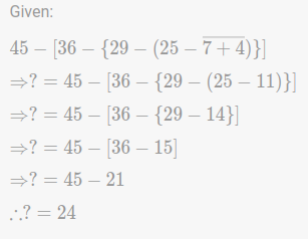
12. 
(A) 2
(B) 3
(C) 1
(D) 4
Answer: B
Explanation:
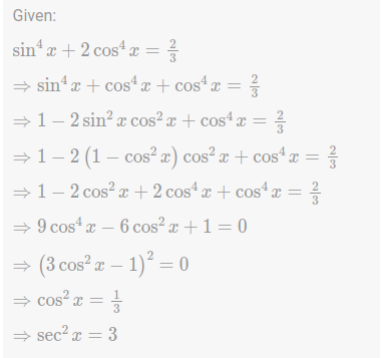
13. A student has to obtain 40% of the total marks to pass. He got 150 marks and failed by 50 marks. What are the maximum marks?
(A) 500
(B) 550
(C) 480
(D) 520
Answer: A
Explanation:
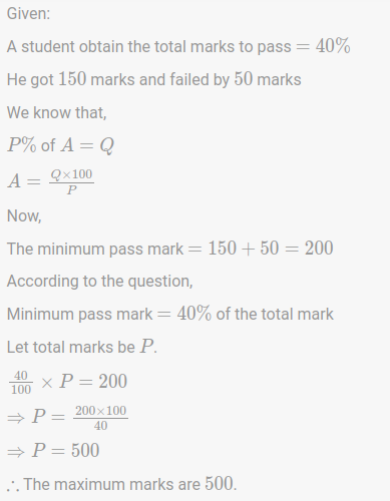
14. The speed of a boat in still water is eight times the speed of the current. The time taken by boat to cover 315 km downstream and 385 km upstream is 18 hr. Then, how long will it take the boat will to cover 225 km downstream?
(A )4 hr
(B) 5 hr
(C) 9 hr
(D) 6 hr
Answer: B
Explanation:
Given:
Speed of boat in the still water =8× Speed of the current
Time taken by boat to cover 315 km downstream and 385 upstream =18 hr
We know that,
Distance = Speed × Time
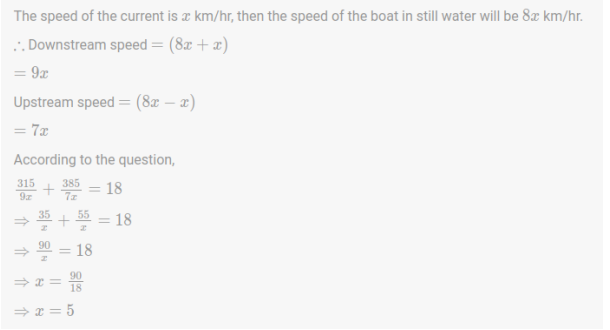
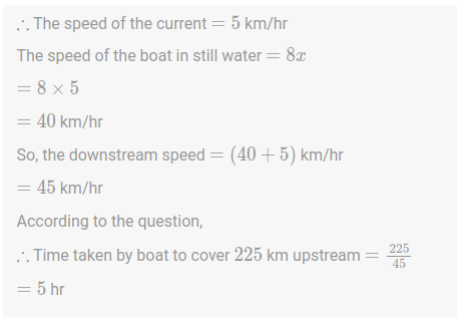
15. Direction: Read the chart carefully and answer the following question.
The bar graph shows number of bikes sold by 4 companies in 2019 and 2020.
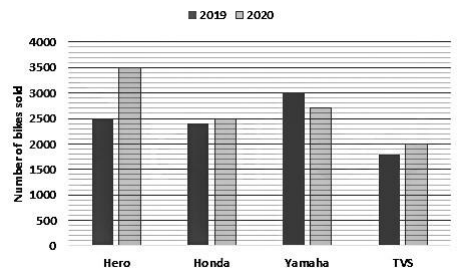
What is the difference of average of bikes sold by Hero and TVS together in 2020 and average of bikes sold by Honda and Yamaha together in 2019?
(A) 150
(B) 100
(C) 70
(D) 50
Answer: D
Explanation:
Given:
Bikes sold by Hero in 2020 = 3500
Bikes sold by TVS in 2020 = 2000
Bikes sold by Honda in 2019 = 2400
Bikes sold by Yamaha in 2019 = 3000
Formula:
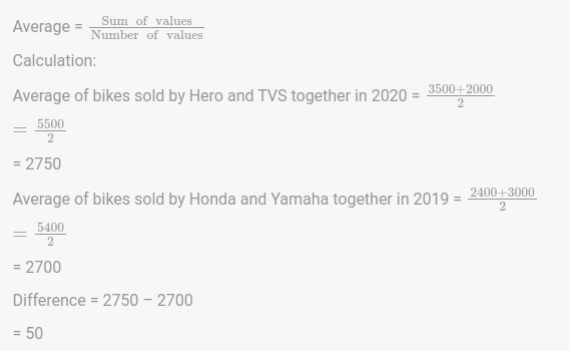
∴ The difference of average of bikes sold by Hero and TVS together in 2020 and average of bikes sold by Honda and Yamaha together in 2019 is 50.
★★ You Can Also Check ★★
- SSC CHSL Free Mock Tests
- SSC CHSL Syllabus
- SSC CHSL Mathematical Abilities Questions and Answers
- SSC CHSL General Awareness Questions and Answers
- SSC CHSL General Intelligence Questions and Answers
- SSC CHSL English Language Questions and Answers
- SSC CHSL Computer Knowledge Module Questions and Answers
- SSC CHSL Salary
- Best Books for SSC CHSL
- How To Crack SSC CHSL Exam?
- SSC CHSL Previous Question Papers



